In this article, I'm going to provide you with a framework you can apply as an individual, just for yourself.
Maybe you're not going to move mountains this year, but you're going to start finding a level of confidence in order to attempt that next year.
We're going to go over how to become a strategic partner to your business and product teams and I say 90 days, that's only because it's been my experience at multiple companies that it's around that 90-day window where you've got that trust - maybe you have a hero that's helping champion you, and you start getting those little those little tiny wins that basically build the runway for the big wins that matter.
So, I've written this article with discovering what your superhero powers are in mind. There are probably three things right now that are going on in your career and your role and your life and those three things basically button up into one, right? Redefining your role.
I am learning more and more that the PMM function is in an evolution state right now and in some companies revolutionary. Number two, how do you become a become a strategic partner, fill in the blank of that cross-functional department? And then last but not least, building a house of innovation. So that's what we're going to do. We are going to tap into your superpowers. Here they are:
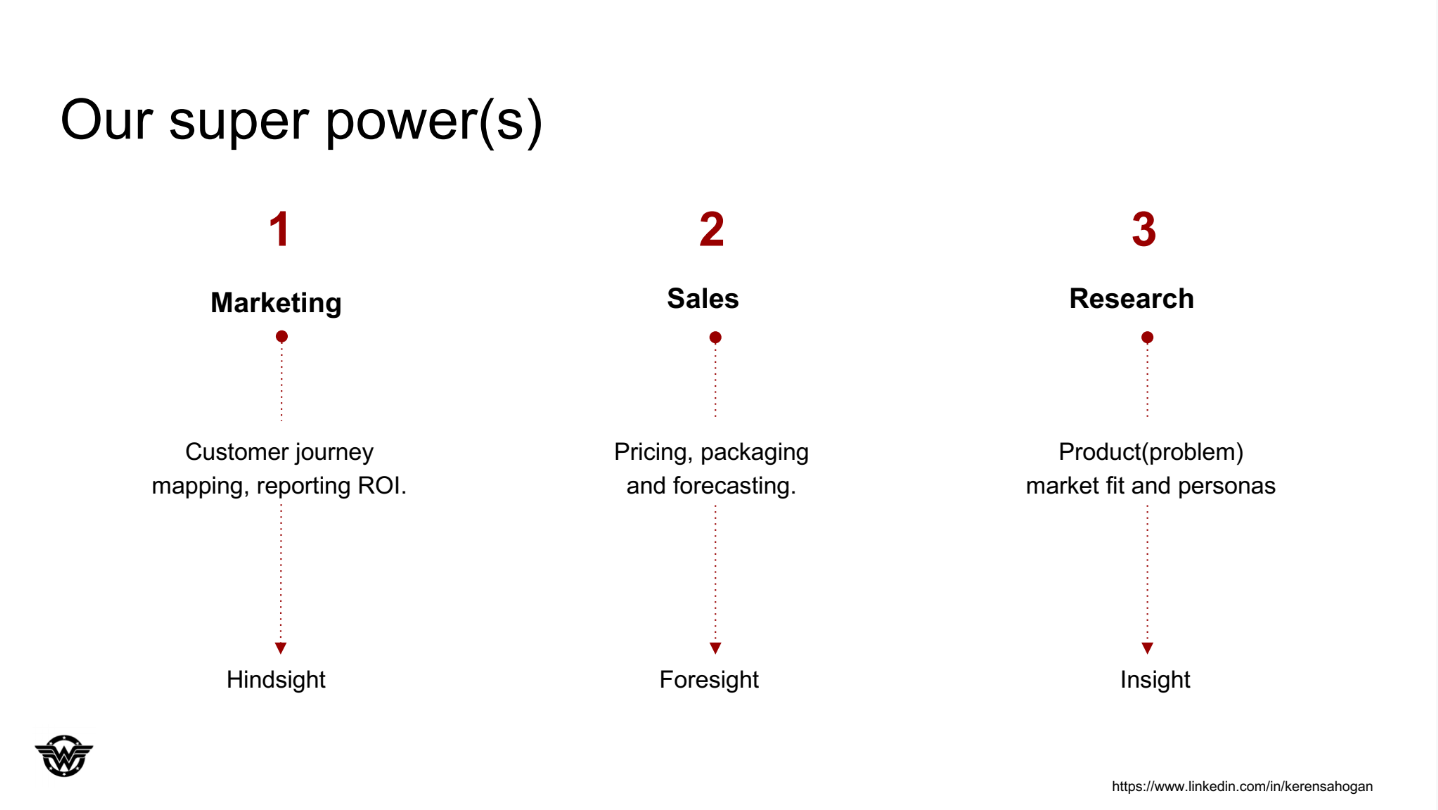
I'm not going to tell you anything you don't already know and you don't already do, but you're doing it for your business and you're doing it for your products, but this is where you're going to remember I'm going to do it for myself.
Number one, marketing. We've seen it all. We've seen successes, we've seen failures, some of those are ours, but we turn that knowledge into another success. We possess hindsight.
It's very important. We possess the ability to sit in a room and hear everything everybody's wanting to do and go "Oh, do you remember when we did this and what happened there?" We even know and think about those questions that aren't being asked and we pursue the answers that need to be discovered. Hindsight.
Do we do sales?
Number two, sales. I had a great conversation recently where I was like, do we do sales? Do we? And yeah, we do, as a matter of fact. We're out there thinking about pricing and packaging, we're basically that person shaking that eight ball and being like, what is going to happen today? We're asked to forecast the future. Thus, foresight.
Number three and this is my love right here, research. We are asked to basically understand a behaviour that may not even be ours intrinsically. We're asked to own it, to wear it, to feel it, to be it, and that's where research comes into play because it helps guide that conversation in a constructive way. Thus, insight. So again, the superpowers you're already possessing, you're actually already doing them every day. But sometimes you forget to do them for yourself. And that's how you become to find the centre and you go back out into the universe, and you start winning.
Product marketing's kryptonite
Every superhero has that moment where she hits rock bottom, her kryptonite. In product marketing, our kryptonite is when we're put on the peripheral. If you've read the State of Product Marketing report, you're going to see some pretty interesting numbers. Of the PMMs who were surveyed, over 50% said that they are responsible for revenue at their company. So we do, do sales, we just don't get the compensation, but we're doing it. And then 45% said they're responsible for increasing and Marketing Qualified Leads. So we're out there looking for the needles in the haystack and then another 42% said that we're also responsible retaining customers. When you don't give us a seat at the table, when we can't get there - roadmap, pricing, packaging, identifying those unmet needs, but you're telling us we're responsible for these things, you become marginalised. And that is not a good feeling for anyone.
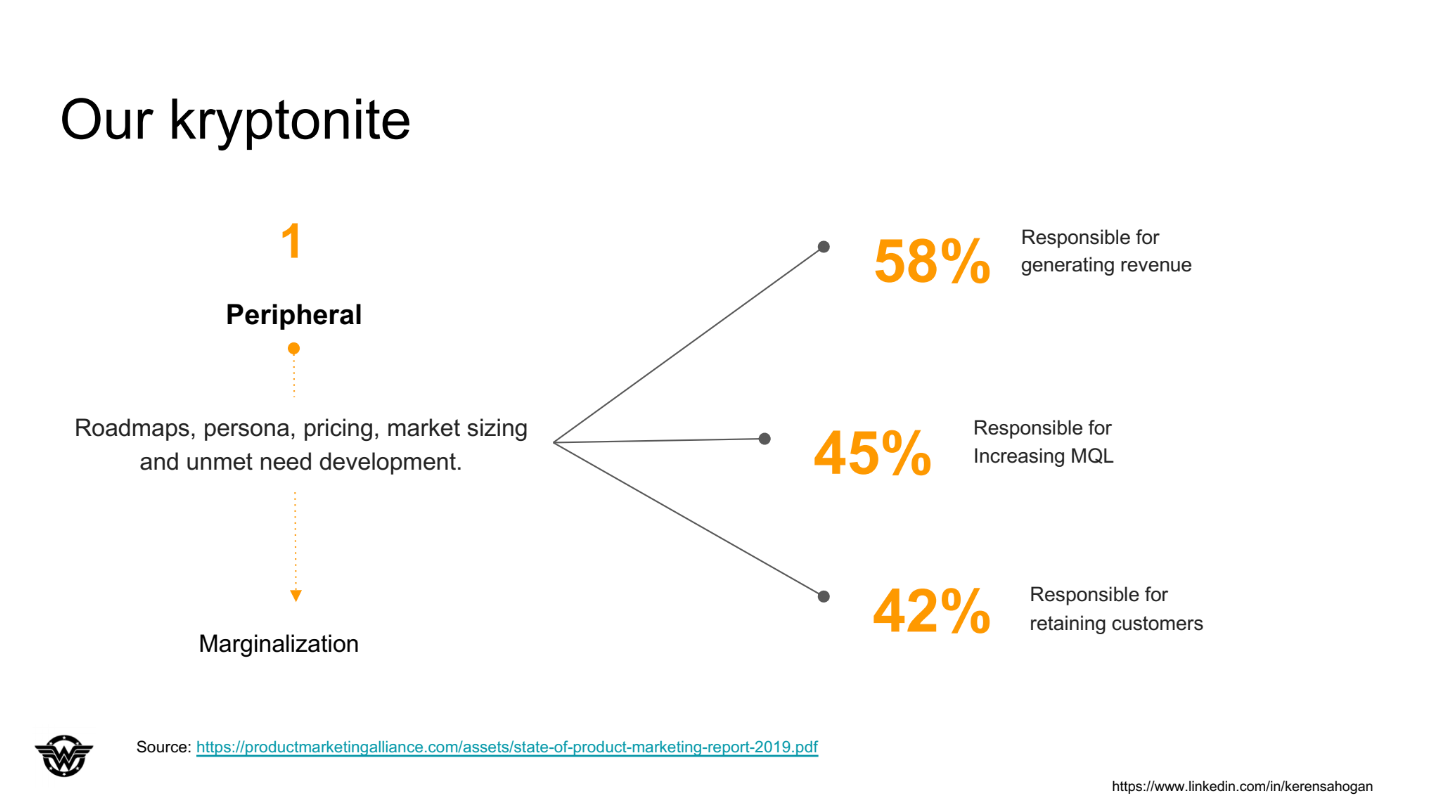
That's something that kind of ebbs and flows, right? I've worked at multiple companies and you have that moment where you're like "This is the year." But you ride it out. So what I'm going to do now is I'm going to take you through a framework that I have followed, and it's a framework for when it's like "I'm not ready because my culture, or my approach, or the team I'm on right now isn't ready for something like this today". So we're not going to turn that into a process for our department, you're going to take a step back and practice it for yourself. So you figure it out. Again, this is a framework and a methodology that I want you to turn into yours and, hopefully, this is a guide that gives you that rigour that you can apply and then find that balance for speed.
The power of three
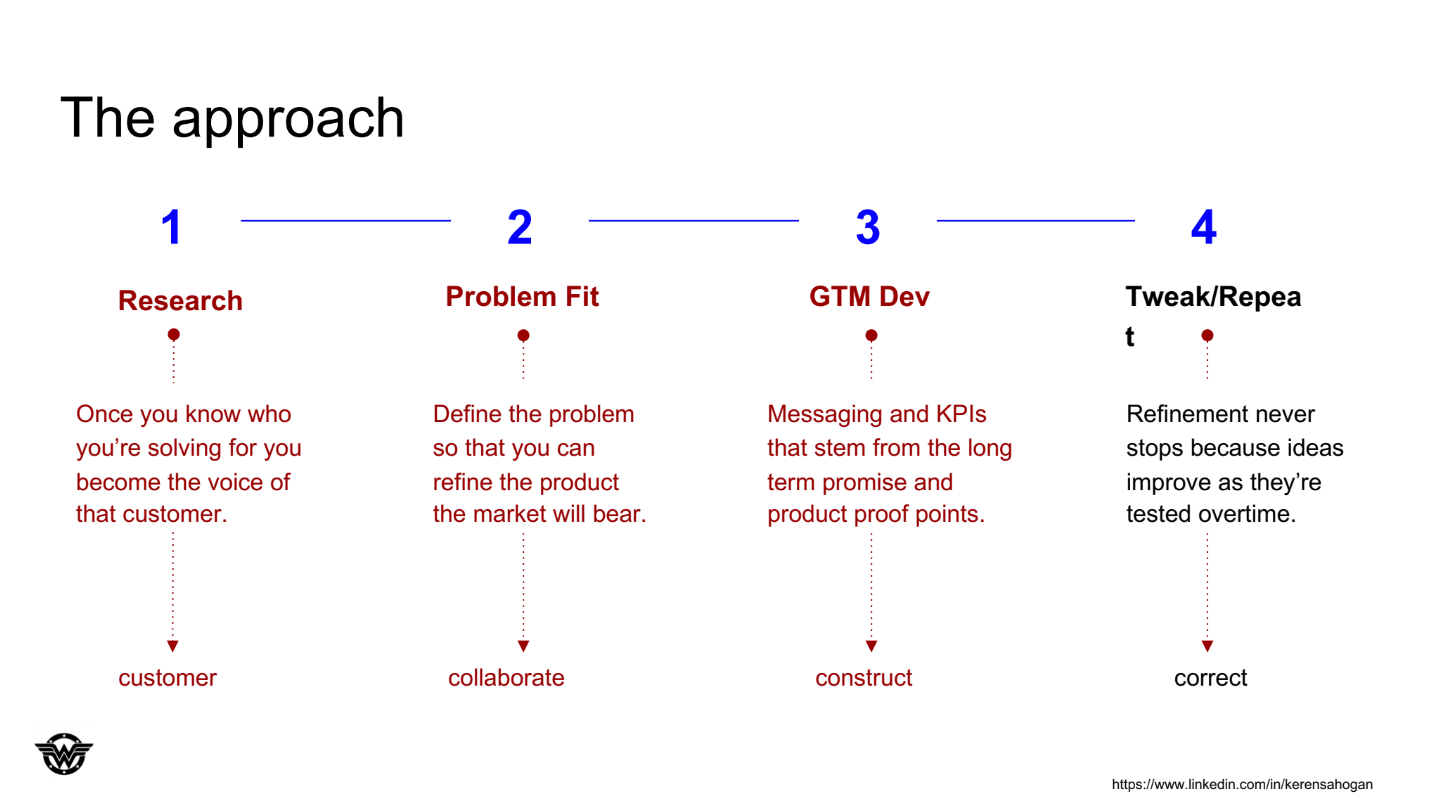
Okay, the power of three, we all know this, right? So number four, it's shaded out because that's just tweak and repeat. That's what we do all the time. That's what we're constantly doing to perfect what's going on and of course correct what's going wrong. So we're going to focus on these three here right about now.
1. Research
We start with research because once you know who you're solving for, you get your North Star, and that North Star, we're like actors, okay? You tell us this is the customer and we're all there. You're like, I want to cast you in a series called Stranger Things and then we're shaving our head, we're putting a little tattoo on 11, and we'll be running around. We own it. That's our passion and our poison, but we're super valuable because that's what's going to win the businesses, the growth of the customers. That being said, we start with customer.
2. Problem fit
Number two, we go into this problem-fit world, right? Where if you know who you're solving for and now you've heard what those things are that are missing for her, now you go to market and you basically calibrate those conversations into a place with your product teams around this is what's right. I'm not a big fan of romantic comedies but if you are Netflix and you're like "I have to grow romantic comedies for people, I gotta go find the ones that don't like them". You'd probably call me up and I'd be like, "I'm busy". But if you did your research, you knew your target customer, and you understood what was missing for me, you would produce something like Isn't It Romantic. It was hilarious. It was dark. It was sarcastic. She spoke my language and she changed the format up a bit. Now I'm like, maybe I'll give romantic comedies another try. And that's that problem-market fit. They figured that one out because they did the research and they calibrated with their product team.
3. GTM dev
The last one I've got is GTM dev. I like GTM, I'm a graphic design fan and so I like how it looks, but the reality is is that this is the development of that. And so this is also very, very important here because, yeah, it's going to have messaging, it's got to have KPIs, but we're going to build it with the same people who not only are on the line to make that product live and go out there, but also the teams that are doing those run of show parts, right, where it's not just "I have declared this is the GTM now, Japan, make that work. I have declared this is your goal, AMEA, hit that number". You build that together. A lot of people like the word collaboration. That's a great one, right? But have you ever experienced yourself with a decision by committee level of collaboration and you just go into this nightmare of churn? And then someone goes, yeah, you've got to ship that yesterday. So you've got to find that balance and that balance starts with developing something really important and pretty massive, with everyone else who's responsible for its success.
Let's deep dive...
I said I'm going to give you a framework but I want you to be able to adapt it for you and the only way you can actually do that is if I talk you through the logic and you take that logic and build it for yourself. Let's talk about research and we're going to talk about some really fun words like qualitative and quantitative. They're super sexy, super fun. But what that is, is that's you getting to know your customer.
That's also you understanding the depth at which that customers feels are the marketplace you're looking at. So, from essentially a qualitative standpoint, there are four basic deliverables you're going to be asking yourself to create.
Again, I'm saying this as "Maybe you just start with you and then next year you start with they". That can happen. You're going to be looking at artefacts, think of it like that, this is an artefact that I use to keep myself on point and get me in a situation where I can articulate these points in a way that Peter can internalise for his business unit or for his product team and his engineers.
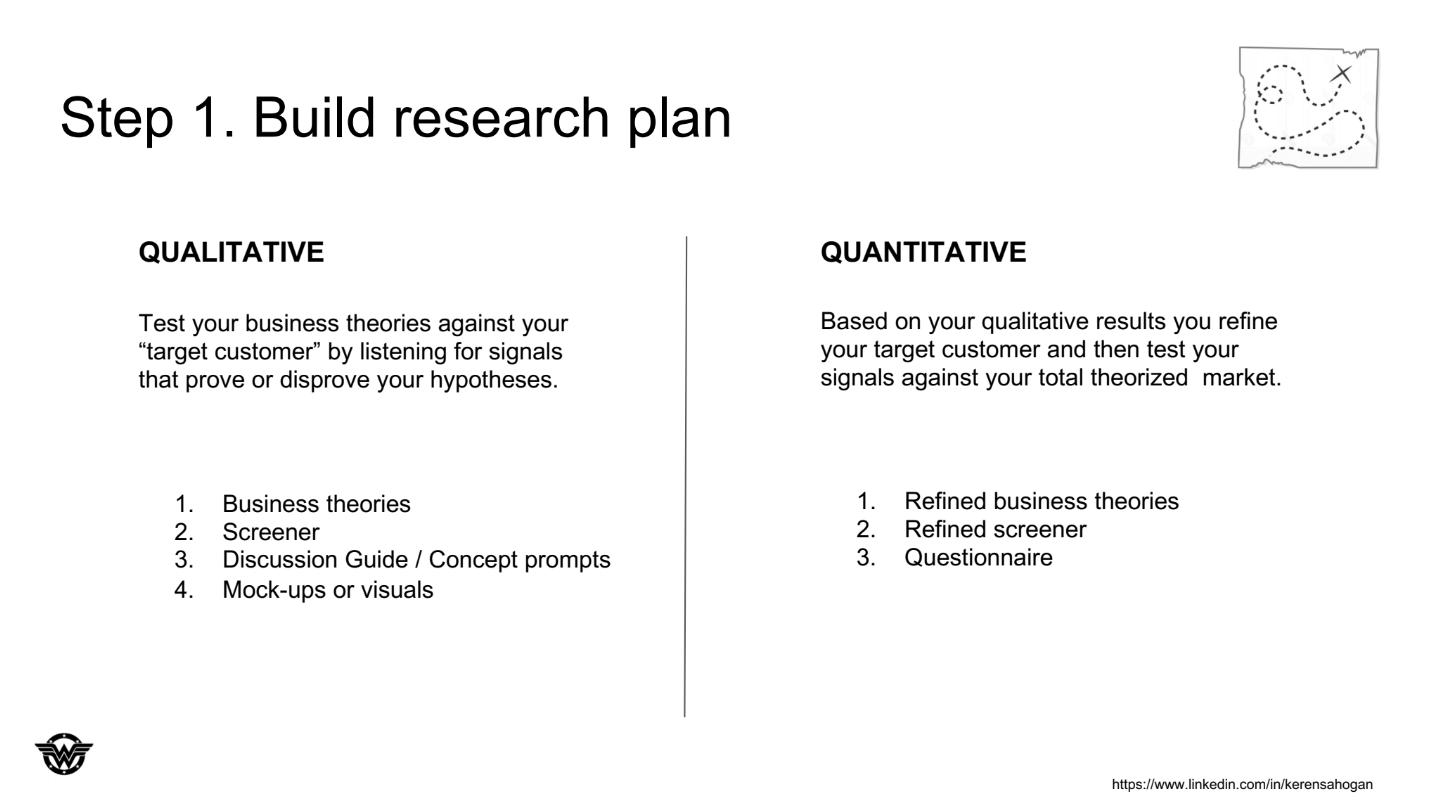
One, what are your business theories? I usually have to rein myself in from this excitement because it's like world domination. That's not quite real, right? Or someone gives you 17 and you're like, yeah, research can only do what it can do, so you bring that down into a world that's real and in language that makes sense. S
o that starts with the target customer, that starts with what are the long term goals of this product, whether it's a line extension development or it's net new. Business theories. This is what you're going to use to prove or disprove. If you prove it, great, if you disprove it, awesome. You know where to pivot.
Two is that screener above, that screener is important. I've seen screeners that are four bullet points I've seen screeners that are four pages. This is where you're refining that target customer and you get everyone on the same page. I've been in places where it's like "We know our buyer is a Vice President". Yeah, right. You talk to a sales rep and they're gonna go so I have like a 19th month sales cycle now because to get to that VP, forget about it.
My brother only knows so many people. You bring that in right? You start grandiose and then again, you bring it down to an eighth grade level to digest this information and get very specific. You know, this is your map in the conversation so you don't derail and go off on little tangents. When you're doing this qualitative research, what are you going to be asking these individuals? How do you navigate those questions and the potential answers back to those forks in the road that you need to prove or disprove those business theories?
Last, and this is a nice to have, mockups - visual stimulants. If you've got a net new product that people are like "I don't really know how much of my skirt I want to pull up because my competitors might find out", that's fine. But at a minimum, you need something that's going to solicit an answer and give context in that qualitative conversation.
Then you get this information and you get into the fun stuff, the quantitative. This is where a lot of what you've learned in those 10 or 14 interviews add up and you start to say "Oh, I heard some signals". Those signals and curiosities cause and create major deviations. Do we explore them? Do we ignore them? Completely up to the circumstances, but now this is where you're going to throw some numbers at that situation because you might find that Kerensa's your target customer and Kerensa doesn't like vanilla ice cream, but you're a CPG company, you're Nestle, and you're like "Oh, that's a big part of our business". But you might find that only 7% of the Kerensa's care. You're like "We're good. We're gonna keep going". Or, you could find that it's more like 97% so you're like "Yeah, not we're not doing vanilla ice cream this year". Refine those business theories. That's the first artefact there. You refine them against those signals. So now you start to understand this is what we thought, pushed against what we learned, this is what we're going to do.
Refine, refine, refine
Number two, refine that screener. You started out with VP and C-suite and now you're like, just to get those turkeys on the phone took me six months, just to do an interview I'm going to pay them $350. It's probably not going to be your target customer, at least for your sales team. Again, it's refinement. And then last but not least, is that questionnaire, that questionnaire is where you're going to get those data points that 7% of our target customer like it versus 70%. And again, this is something you do for yourself to put yourself in a situation where you can then go have that articulate conversation, or you hire a vendor, or you work with your market research. That's what you're going to do. Take these artefacts, build them as you choose, use them for yourself.
The next deep dive is problem market fit, you probably hear product market-fit a lot, but I'm a PMM and I think about solving problems so I like to think of it as the problem-market fit. Now what we're doing is we're navigating to something tangible - not inspirational or aspirational, but tangible, and that's what people vote for with their wallets. So when you start here, you're picking it up from the research, you're synthesising all that information, all of those verbatims, all of those quotes that Greg over here is going to use in a meeting and say "Yeah, well, remember qualitative, Kerensa said..." Well, Kerensa's only 7% of the market, thank you, Greg. Thank you. What's next?
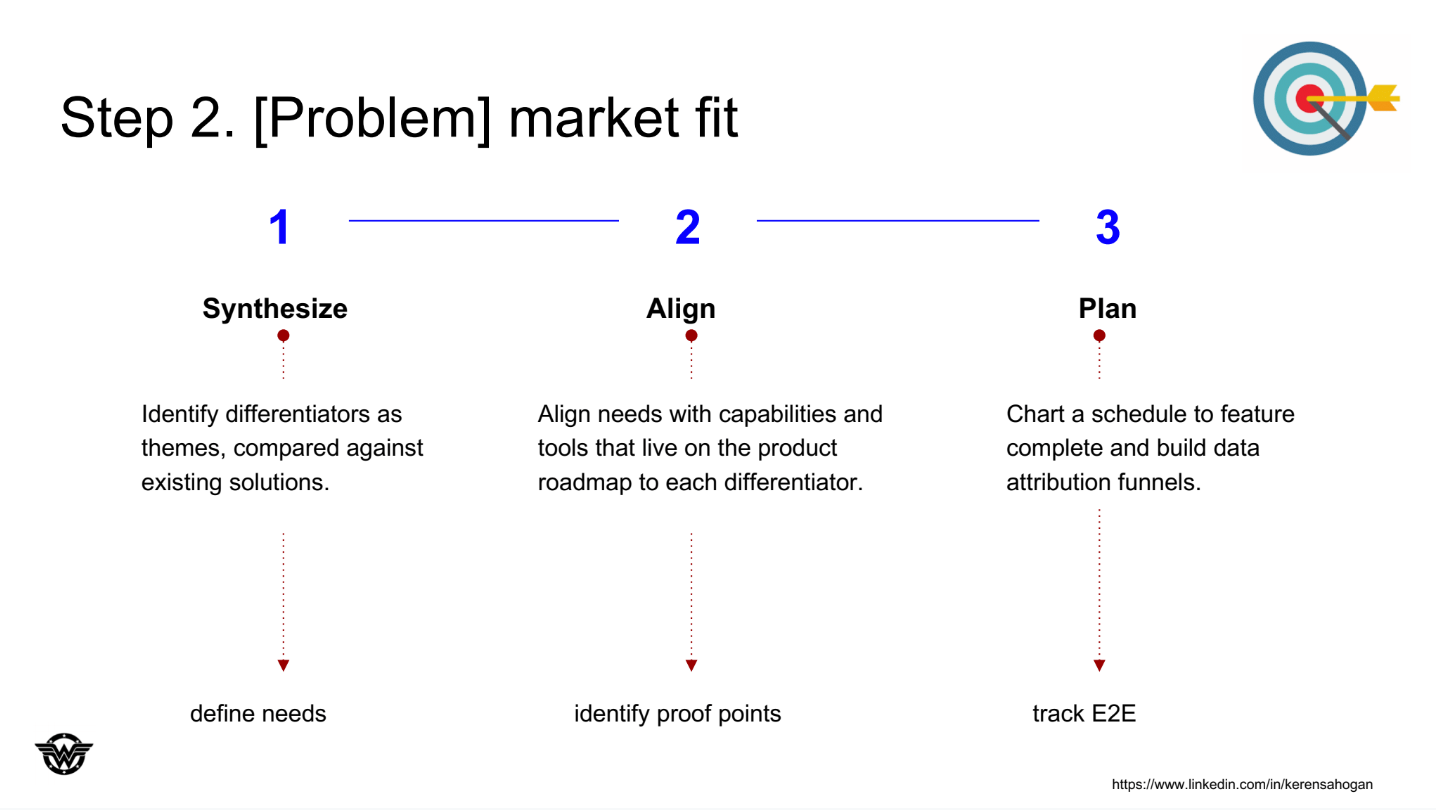
You synthesise all that information into themes. We are storytellers, right? You give us a theme, we will rock the house with that theme. This is where you create those themes. You put them in logical language to where you then go and align. Call up Greg who's your product manager like "Hey, I've got something to share, you're gonna love this" and you sit down with Greg and you essentially identify, let's say three things, three benefits, three values, three pillars - whatever your company uses as that vernacular, but the three reasons why we're going to build this baby and win the market. And you say "Hey Greg, what are you building in the product that's actually delivering on that? What's the proof? What's the proof that this is an easy to use product? What's the proof that it's actually highly performant? What is the proof that we're committed to interoperability?" And Greg might scratch his head and be like "Well, here's my roadmap" and you're like "Nothing here Greg, none of that's in here, is it too late?" Or, you're gonna be like "This is crazy. Explain this to me," and I have used this language before with product managers, "My job is to get what's in your heart and in your head to the world. Will you let me do that for you? I need you to help me get inside your head and inside your heart. Let's do that together." You identify the proof points and last but not least, you plan. This is where we actually plan with our PM against that release. So you're asking things like:
- When are you going to be feature complete?
- When's QA shipping?
- Have you tested this with the cloud tech team?
But essentially they're right there with you and you're building a funnel, right? A funnel that you can actually then go, well, these were the three things we said that we were gonna fulfil those unmet needs. These are the proof points that we are shipping in this product. And now we're going to track that. So if we said it was easy to use, well, Greg, how long do you think it should take a person to download this app? Or, Susan, what's the time in which someone should be able to expedite these three actions that we think are the most valuable actions someone should experience to understand the value? And then we're going to track against that, and then they're with you and they're like, we're going to build those funnels to do that data attribution right. You're tracking that end-to-end journey that you specified from the beginning and the experience.
You've got how many slides?!
Next is the GTM development. And again, the reason I call it a development is because have you ever written a GTM that was 63 slides? I have. And have you ever looked at it and wanted to kill yourself because you're like, how did I get to 66? Who is even gonna read this? And the one that you present to your C-suite is like three slides, and you're like, what?
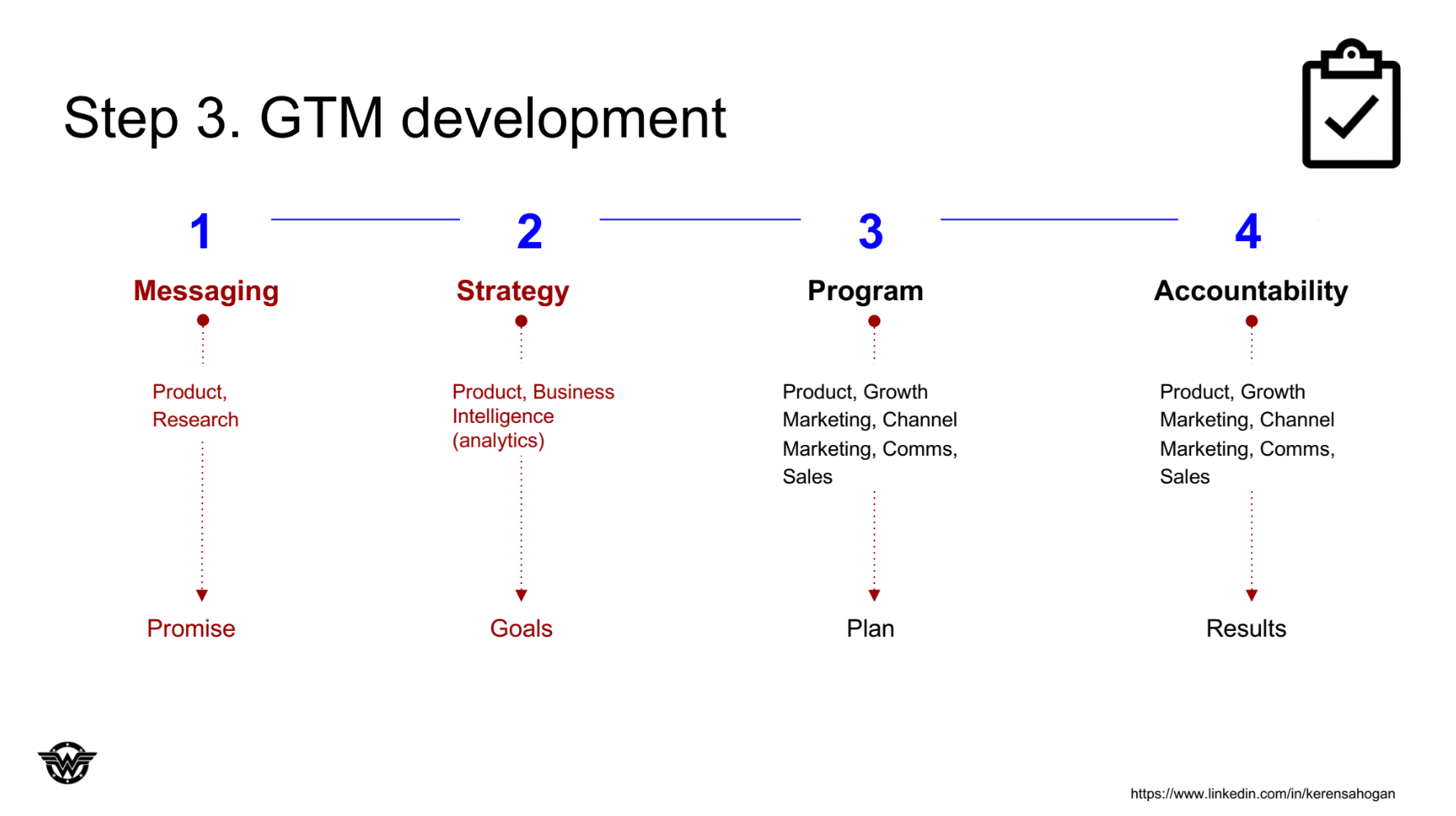
This is how that happens. Again, there are some sections here, three and four, we're not going to go into because you all know this it's what you do for a living. You build that plan with your comms team and everyone else and you get your run of show and then you put it out in the world and then you do your 30 your 60 and your 90 day accountability check-ins. We're going to focus on one and two one and this is again a methodology so you can walk away and be like "I heard this, I wanted this, but I'm going to do all of this."
Messaging and strategy
So messaging and strategy. These two steps I work with different teams on, but it just so happens product is in both. Again, now you got the seat at the table, you've got Greg and Susan's attention, and now you're speaking from a very articulate place because you got your data points and they're just like "Show me the way." For messaging, I always work with product and research. You might be a research team of one and that is okay, but, like I said, when you sit down and you say "Did we build these three things in there? What are those proof points because if we're going to make these promises in our content and all of our collateral, we've got to pay out on those promises." You build the messaging there and then in the strategy.
I talked about the data attribution piece, building out that end-to-end, this is when I sit down with product because I need them here with me and I need business intelligence or analysts or data scientists, whatever title you've given to that individual that basically goes into Tableau for you and you say "What is the data that we have? And can I get that data on an hourly basis? Or can I get that data faster than in one week?" And the reason why I give that parameter is because technical people, developers, engineers, etc. will say I can do anything but you need to give me time and money. When it comes to data, I never have so it's just a case of what already exists? Can I get that data on a regular basis by myself so that I can do those wrap-ups? So that's how I set this up because you've got to set yourself up for success, right? There's nothing worse than promising all these things and then none of it actually happening. So let's roll down. Messaging, here you go, this is our messaging I made up when I worked for Adobe:

This is an example of messaging I wrote for a product that might be out now and what I did was I sat down with my product person and those business theories we started out with, this one came through and true the whole time. Ultimately, we were building 3D software for graphic designers and the thing that consistently came out of all that qualitative and quantitative research was that they were like "I am not spending 10,000 hours, again, to learn new software and 3D software is super crazy. I don't know what to touch." So easy to use with something we had to really double-down on. My messaging focused on that value and then the language that directly addressed the objection that they had to all of the competitors or the current solutions out there. Look at this little list right here:
So I built this in sheets and I had a really hard time with the bullets, so you get like a stream of consciousness, but these were the product components - some of them real, some of them not, that the product manager said we're shipping these things that marry up into that, but they're going to actually tangibly feel. So this is an example of a messaging exercise that I would do with my product manager and we come away really happy about, and then my product manager always had my back when we went somewhere else and someone was like "I just don't like the word friction-free" or "I don't like this verb", and my PM was right there with me being like "Eighth grade, eighth grade language" and we became partners. He basically helped me enforce this messaging and enforce this strategy. Here's a breakdown of the strategy:
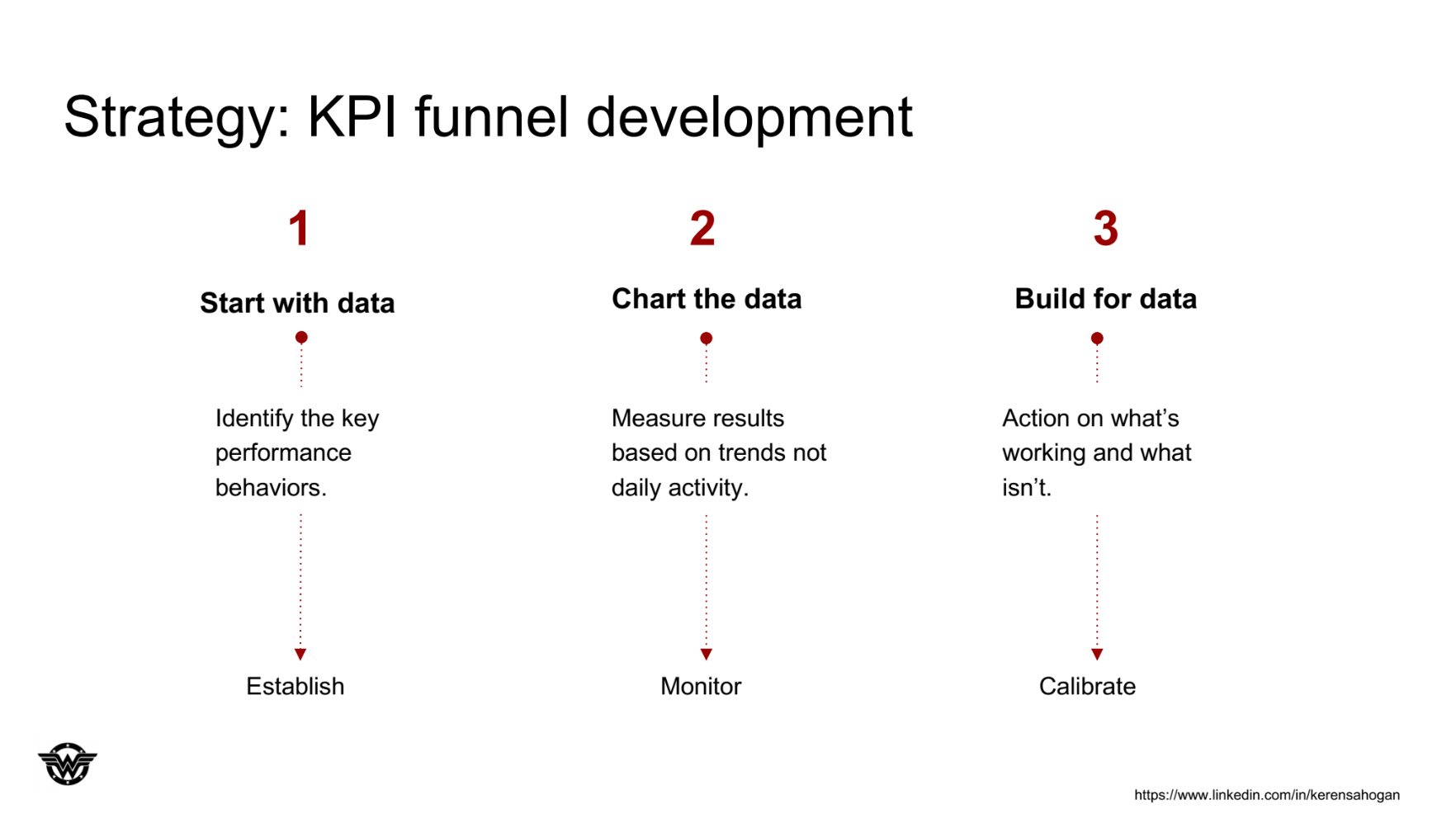
Look at all that data, data, data, data, data. How many times are you asked to be more metrics-oriented? How many times are you asked how do you measure this? Can you met? Can you measure this over here? So you start with data. Remember, I said I sit down with the people who are super smarter than I am and what's available? We establish what it is that we can actually report back against. Because again, if you can't report on it it's like it didn't happen. Or if it did and it was a success, you didn't do it. So you establish what it is we can in fact track, then you move into charting against that and I like using the word feature funnel, and when I say something's easy to use, I expect to it to be easy to use, but I also expect to see some little moments of faith and a milestone in that journey. When I'm touching an app, I expect to see this menu's option tab X number of times, if there's an output like 'Save As' I expect to see 'Save As' expedited every day. If it's easy to use, people should be able to say whatever it is that they did. So you chart your data points that you're going to capture to report against your funnel here.
Use your proof and data points
Last, build for data, and this goes back to those business theories and making sure you've got those proof points. If you said this was easy to use, it better ben right? If it isn't, you have the data points to inform you on where you need to pivot. So if you thought X number of people were going to download it, and then X number were going to create a login, or X number were going to then immediately create something, and people aren't even downloading it, we're brilliant, because what we know is we need stronger awareness, or we need activation reminders. We need a drip campaign. We know how to fix it. But we can't find the cancer if we don't know what the symptoms are surrounding it and that is what this does.
So your superpowers that you do every day, but you stopped doing them for yourself, is this right here hindsight, foresight and insight:
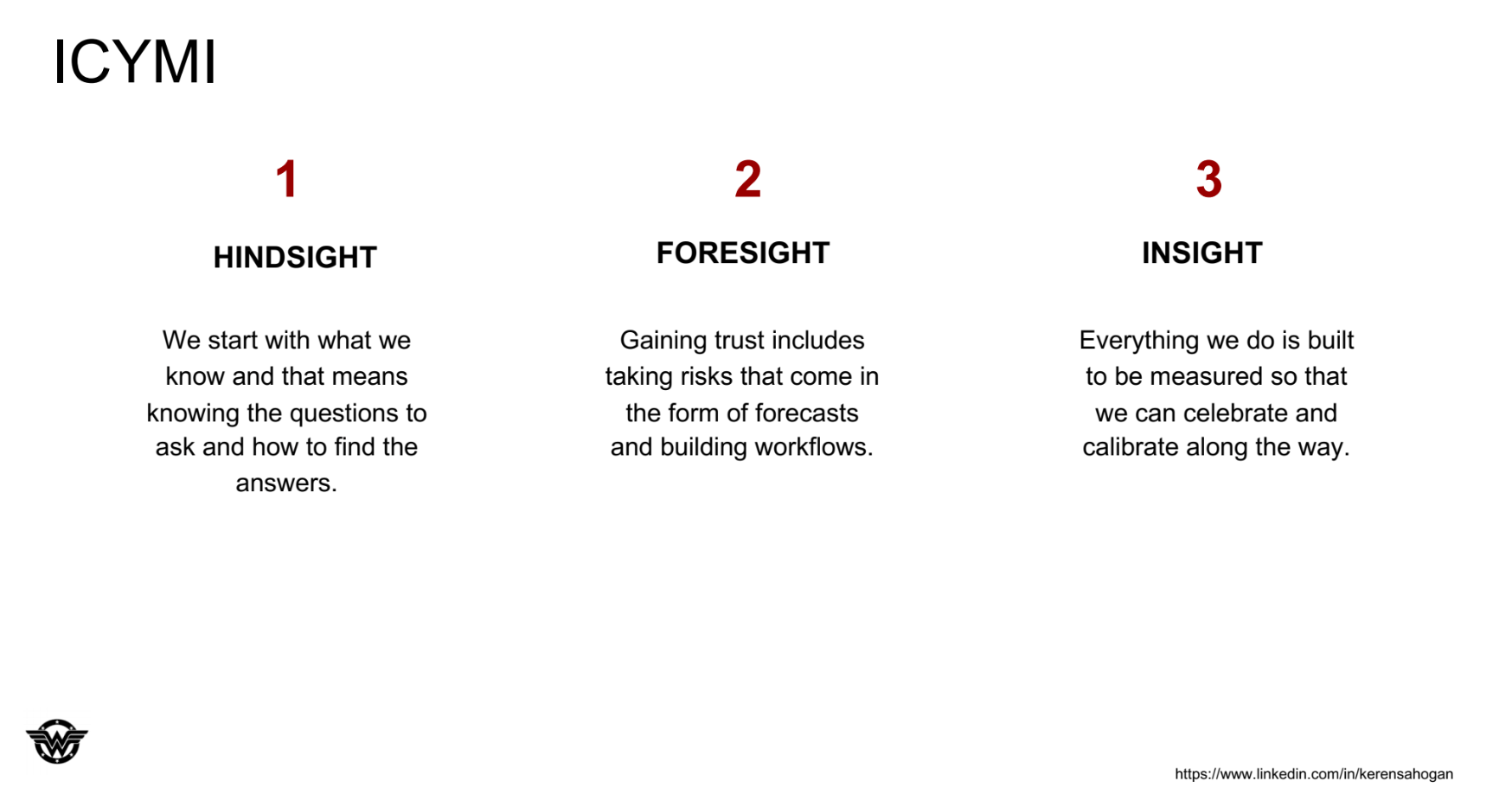
You're doing them when you write those GTMs, now you just need to do them for yourself a little bit and you need to figure out how you start to insert this area of expertise for myself and my relationships? How do I find that dose of confidence to speak with conviction? Not confrontation, conviction. How do I show and remind people, yeah, I kind of know what I'm doing, can you let me do it? And by the way, I'm a relationship builder, so I want to do it with you. That's what we got.


















 Follow us on LinkedIn
Follow us on LinkedIn



.svg?v=3c4c23cd72)